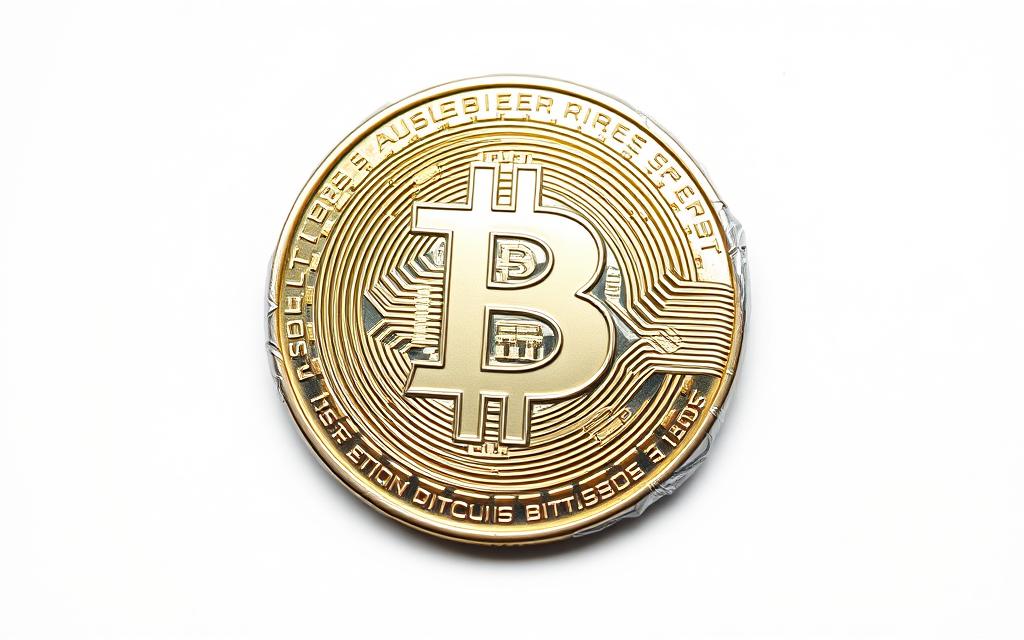Table of Contents
Wrapped Bitcoin (wBTC) is revolutionizing the cryptocurrency landscape by bridging the Bitcoin and Ethereum ecosystems. Launched in January 2019 by BitGo, Ren, and Kyber Network, wBTC is an Ethereum-based token that represents Bitcoin at a 1:1 ratio, enabling users to access Ethereum’s decentralized finance (DeFi) applications.
This innovation has brought increased liquidity to the DeFi ecosystem, providing Bitcoin holders with access to various financial services. For more information on wBTC, you can visit Gemini’s Cryptopedia, which offers a detailed overview of Wrapped Bitcoin and its applications.
By allowing Bitcoin to be used on the Ethereum network, wBTC has opened up new avenues for cryptocurrency users, enhancing the overall cryptocurrency ecosystem.
Understanding Wrapped Bitcoin (WBTC)
The concept of Wrapped Bitcoin (WBTC) has emerged as a significant innovation in the cryptocurrency space, enabling seamless interaction between Bitcoin and Ethereum. This development has opened new avenues for Bitcoin holders to participate in the decentralized finance (DeFi) ecosystem.
Definition of Wrapped Bitcoin
Wrapped Bitcoin (WBTC) is an ERC-20 token on the Ethereum blockchain that represents Bitcoin at a 1:1 ratio. This means that one WBTC is always equal to one Bitcoin (BTC). The WBTC token is backed by actual BTC held in custody, ensuring that it maintains price parity with Bitcoin. By tokenizing Bitcoin on the Ethereum network, WBTC enables users to leverage the benefits of both cryptocurrencies, combining the value of Bitcoin with the smart contract functionality of Ethereum.
The concept of wrapped tokens is fundamental to understanding WBTC. Wrapped tokens are cryptocurrencies that are pegged to the value of another asset, in this case, Bitcoin. They enable cross-chain compatibility between different blockchain networks, allowing assets from one blockchain to be used on another. For more information on Wrapped Bitcoin, you can visit this resource.
The Origin and Development of WBTC
The WBTC protocol was developed by a consortium of companies including BitGo Inc, Kyber Network, and Ren (formerly Republic Protocol). The WBTC whitepaper was released on January 24, 2019, and the token was launched on January 31, 2019, with eight merchants facilitating bitcoin-to-WBTC conversions. The initial development of WBTC was aimed at solving the interoperability problem between Bitcoin and Ethereum, allowing Bitcoin’s liquidity to flow into Ethereum’s DeFi ecosystem.
The WBTC protocol was designed to provide a secure and transparent way to wrap Bitcoin onto the Ethereum network. The role of the WBTC DAO (Decentralized Autonomous Organization) is crucial in governing the protocol and ensuring transparency in the wrapping process. By decentralizing the governance, WBTC ensures that the protocol remains secure and trustworthy.
The historical development of WBTC has been marked by significant milestones since its launch. As the DeFi ecosystem continues to grow, the adoption and use of WBTC have expanded, providing Bitcoin holders with more opportunities to participate in DeFi applications.
How Wrapped Bitcoin Works
To understand how Wrapped Bitcoin works, it’s essential to delve into the wrapping process and the roles of key players involved. Wrapped Bitcoin is created when a user requests Ethereum-based ERC-20 tokens, known as WBTC, from a merchant in exchange for their Bitcoin.
The Wrapping Process Explained
The wrapping process involves several steps. First, a user sends their Bitcoin to a merchant, who then performs Know Your Customer (KYC) and Anti-Money Laundering (AML) verification. Once verified, the merchant initiates a transaction with a custodian, currently BitGo, who mints the corresponding amount of WBTC. The WBTC is then sent to the merchant’s Ethereum address.
Next, the user and the merchant perform a trade, either through a centralized exchange (CEX) or a peer-to-peer transaction, known as an atomic swap, on a decentralized exchange. This leaves the merchant with the original Bitcoin and the user with WBTC. The user can then utilize their WBTC on various DeFi platforms like Compound and Aave.

The Role of Custodians and Merchants
Custodians play a critical role in securing the actual Bitcoin that backs WBTC, maintaining a 1:1 peg between the assets. BitGo, the current custodian for WBTC, ensures the safekeeping of the Bitcoin reserves.
Merchants act as intermediaries, facilitating the wrapping and unwrapping process for users. They handle the initial request, perform KYC/AML verification, and interact with the custodian to mint or burn WBTC tokens. The WBTC DAO oversees the protocol through multi-signature wallets and regular proof-of-reserve transactions to ensure transparency.
When a user wants to convert their WBTC back to Bitcoin, they initiate a request with the merchant, who then reverses the process. The WBTC is traded back, and the merchant destroys the WBTC in a “burn transaction,” ensuring the integrity of the system.
- The wrapping process involves sending BTC to a merchant and receiving WBTC in return.
- Custodians like BitGo secure the Bitcoin reserves and maintain the 1:1 peg with WBTC.
- Merchants facilitate the wrapping and unwrapping process, handling KYC/AML verification and interacting with custodians.
- The WBTC DAO ensures protocol transparency through multi-signature wallets and proof-of-reserve transactions.
WBTC vs. Bitcoin: Key Differences
The comparison between WBTC and Bitcoin reveals significant differences in their underlying technology and functionality. While both are related to the original Bitcoin cryptocurrency, they operate on different blockchain networks.
Technical Distinctions
A fundamental difference between WBTC and Bitcoin lies in the blockchain they operate on. Bitcoin is a standalone cryptocurrency with its own blockchain, whereas WBTC is an ERC-20 token that exists on the Ethereum network. This distinction has several implications, including differences in transaction processing times and the ability to interact with smart contracts.
WBTC’s existence on the Ethereum network means it can leverage the network’s smart contract functionality, enabling more complex transactions and interactions with decentralized applications (dApps). In contrast, Bitcoin’s blockchain is primarily focused on processing transactions.
Transaction Speed and Costs
One of the significant advantages of WBTC is its transaction speed compared to Bitcoin. Because WBTC is settled on the Ethereum blockchain, which adds a new block every 15 seconds, transactions are processed much faster than Bitcoin, which has a block time of approximately 10 minutes.
- Ethereum’s faster block times enable WBTC to move more rapidly between wallets, exchanges, and services.
- The Ethereum network currently processes around 25 transactions per second (TPS), outpacing Bitcoin’s 7 TPS.
- Future scaling solutions like “sharding” are expected to increase Ethereum’s capacity to 100,000 TPS.
In terms of transaction costs, WBTC’s gas fees on the Ethereum network differ from Bitcoin’s fee structure. While both networks have their own mechanisms for determining transaction fees, the cost of transacting with WBTC can be more volatile due to the dynamics of Ethereum’s gas market.
Furthermore, the wallet requirements for WBTC and Bitcoin differ. WBTC requires an Ethereum-compatible wallet, whereas Bitcoin needs a Bitcoin-specific wallet. This distinction is crucial for users looking to store or transact with either asset.
Benefits of Using Wrapped Bitcoin
The integration of Wrapped Bitcoin into the Ethereum ecosystem has revolutionized the way Bitcoin holders interact with decentralized finance (DeFi) applications. This innovation has brought numerous benefits, primarily by enhancing liquidity and interoperability between the Bitcoin and Ethereum ecosystems.
Enhanced Liquidity and Interoperability
Wrapped Bitcoin (WBTC) has significantly increased liquidity in decentralized exchanges (DEXs) by bringing Bitcoin’s substantial market value into Ethereum’s DeFi ecosystem. According to DeFi analytics hub DeFi Pulse, the total value of the WBTC market grew from $665 million to $848 million between August 1 and September 20, 2020. This surge in liquidity has facilitated smoother transactions and more stable markets, benefiting traders and investors alike.

Access to Ethereum’s Ecosystem
WBTC allows Bitcoin holders to access Ethereum’s diverse range of DeFi applications without having to sell their BTC holdings. This means that Bitcoin holders can now participate in lending protocols, yield farming, and other DeFi mechanisms that aren’t available on the Bitcoin blockchain. By doing so, WBTC enables Bitcoin holders to earn interest on their holdings, thereby increasing their potential returns.
The ability to use WBTC in Ethereum’s DeFi ecosystem also helps bridge the divide between “chain maximalists” by creating shared incentives between Bitcoin and Ethereum communities. Furthermore, WBTC benefits from Ethereum’s faster transaction speeds and programmability while maintaining exposure to Bitcoin’s value.
As the number of merchants, exchanges, and wallets accepting WBTC grows, so does the amount of Bitcoin being converted into WBTC Ethereum tokens. This expanding adoption underscores the increasing importance of WBTC in the DeFi ecosystem, demonstrating how it has expanded the utility of Bitcoin.
What is Wrapped Bitcoin Used For?
As a bridge between Bitcoin and Ethereum, WBTC enables a wide range of financial services within the DeFi sector. Its primary use cases are centered around providing liquidity and facilitating various financial operations.
Collateral for DeFi Loans
One of the standard uses for WBTC is as collateral for loans on DeFi platforms. By locking up WBTC, users can borrow other cryptocurrencies without having to sell their Bitcoin holdings. This mechanism allows for the leveraging of Bitcoin’s value without relinquishing ownership.
DeFi platforms require borrowers to secure their loans with collateral, which is held until the loan is repaid. If the loan is not repaid, the collateral is liquidated to recoup the lent amount. This process underscores the importance of WBTC as a reliable form of collateral in the DeFi ecosystem.
Yield Farming and Earning Interest
WBTC can be deposited into lending protocols such as Compound, Aave, and MakerDAO to earn interest. These platforms offer significantly higher interest rates compared to traditional banking systems. For instance, lending WBTC on Compound can yield interest rates around 3%, far surpassing the 0.01% offered by traditional savings accounts.
Yield farming involves strategically moving WBTC between different DeFi protocols to maximize interest gains. This practice has become popular among cryptocurrency holders looking to optimize their returns.
Trading on Decentralized Exchanges
WBTC also enables trading on decentralized exchanges (DEXs) like Uniswap and Curve. By providing liquidity to these platforms, WBTC holders can facilitate smoother transactions and potentially earn trading fees.
Furthermore, WBTC can be used to earn governance tokens on certain platforms, granting users voting rights in protocol decisions and potentially earning additional value.

| Platform | Use Case | Typical Return |
|---|---|---|
| Compound | Lending WBTC | 3% Interest |
| Uniswap | Providing Liquidity | Variable Trading Fees |
| MakerDAO | Collateral for DAI | Stability Fees |
The table above illustrates some of the key use cases for WBTC across different DeFi platforms, highlighting the potential returns for users.
Risks and Considerations When Using WBTC
While Wrapped Bitcoin offers numerous benefits, it also poses significant risks, including custodial risks and smart contract vulnerabilities, that need careful consideration. Understanding these risks is crucial for users to make informed decisions when engaging with WBTC in their cryptocurrency activities.
Custodial Risks Associated with WBTC
The greatest risk associated with WBTC is its high reliance on cryptocurrency custodians, primarily BitGo. Although BitGo releases transparency reports to prove its WBTC issuance schedule, it’s a central failure point. Depositors must trust BitGo will protect their Bitcoin and always have enough funds to repay them when they unwrap their WBTC.
There have been instances where hackers successfully stole BTC from vaults used to create WBTC, such as the 2021 theft of 2,100 BTC from the Ethereum protocol BadgerDAO. This highlights the potential vulnerabilities in the custodial process.
Smart Contract Vulnerabilities
The WBTC protocol is controlled by a Decentralized Autonomous Organization (DAO) with 17 members representing stakeholders from around the DeFi ecosystem. While this governance structure is designed to be secure, vulnerabilities in the smart contracts that govern WBTC could potentially lead to loss of funds.
It’s essential for users to understand that the security of WBTC is not just dependent on the custodian but also on the robustness of its smart contracts.

Mitigating Risks
To mitigate these risks, users should consider using reputable exchanges, maintaining proper security practices, and being cautious about the amount of assets converted to WBTC. Diversifying assets and staying informed about the latest developments in WBTC’s custodial and smart contract security can also help manage risk.
| Risk Type | Description | Mitigation Strategy |
|---|---|---|
| Custodial Risk | Reliance on custodians like BitGo to securely store underlying Bitcoin. | Use reputable custodians, monitor transparency reports. |
| Smart Contract Risk | Vulnerabilities in the code governing WBTC. | Stay updated on smart contract audits and governance changes. |
| Centralization Risk | WBTC’s reliance on a limited number of custodians and DAO members. | Diversify assets, consider decentralization trends. |
Conclusion: The Future of Wrapped Bitcoin in DeFi
As we explore the rapidly evolving DeFi landscape, Wrapped Bitcoin (WBTC) emerges as a pivotal innovation. Since its launch in 2019, WBTC has demonstrated significant growth and played a crucial role in bringing Bitcoin’s liquidity to Ethereum’s DeFi ecosystem.
Wrapped Bitcoin is an Ethereum-based token that represents Bitcoin at a 1:1 ratio, enabling cross-chain functionality. This has unlocked a vast store of liquidity, allowing users to access various DeFi services such as lending, borrowing, and yield farming.
The future of WBTC looks promising, with its role in the evolving multi-chain cryptocurrency landscape expected to expand. Improvements in Ethereum’s scalability and the development of layer-2 solutions may further enhance WBTC’s utility and adoption. However, the emergence of native Bitcoin DeFi solutions or other wrapped token protocols may also impact its trajectory.
Despite potential challenges, WBTC remains a crucial bridge between Bitcoin and Ethereum, facilitating interoperability between different blockchain ecosystems. As the cryptocurrency space continues to mature, the importance of cross-chain interoperability is likely to grow, positioning WBTC for continued relevance.
In conclusion, Wrapped Bitcoin has already exhibited significant utility and delivered value across both Bitcoin and Ethereum ecosystems. As the DeFi ecosystem continues to evolve, WBTC is poised to play an increasingly important role, offering users new opportunities for financial services and applications.
FAQ
How does Wrapped Bitcoin (WBTC) enable Bitcoin holders to access the Ethereum network?
WBTC allows Bitcoin holders to access the Ethereum network by wrapping their BTC into an ERC-20 token, which can be used in various decentralized finance (DeFi) applications, such as lending, borrowing, and trading on decentralized exchanges.
What is the role of custodians in the WBTC ecosystem?
Custodians, such as BitGo, play a crucial role in the WBTC ecosystem by holding the underlying BTC and issuing the corresponding WBTC tokens, ensuring that the token is fully collateralized and can be redeemed for BTC at any time.
How does WBTC enhance liquidity in the DeFi ecosystem?
WBTC enhances liquidity in the DeFi ecosystem by providing a widely accepted and trusted token that can be used as collateral for loans, in yield farming, and for trading on decentralized exchanges, thereby increasing the overall liquidity and usability of the Ethereum network.
What are the risks associated with using WBTC?
The risks associated with using WBTC include custodial risks, smart contract vulnerabilities, and the potential for price volatility, which can impact the value of the token and the overall stability of the DeFi ecosystem.
Can WBTC be used for yield farming and earning interest?
Yes, WBTC can be used for yield farming and earning interest by providing liquidity to DeFi protocols, such as lending platforms and liquidity pools, which can generate returns for WBTC holders.
How does the wrapping process work for WBTC?
The wrapping process for WBTC involves a merchant or custodian holding the underlying BTC and issuing the corresponding WBTC tokens, which are then sent to the user’s wallet, allowing them to use the token in various DeFi applications.









